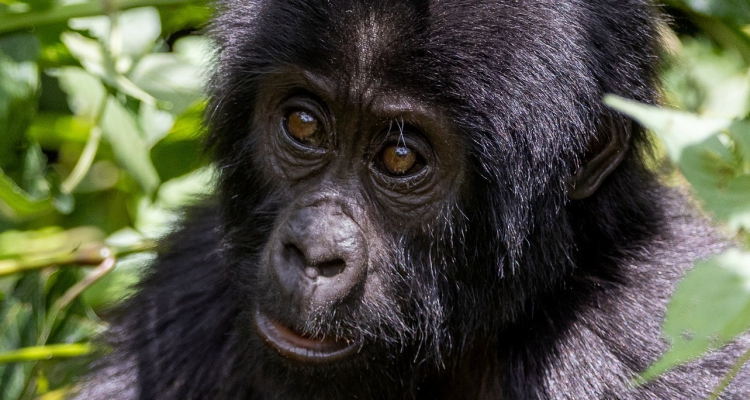Mountain Gorillas-Facts and Where to See them in Uganda
The mountain gorillas (Gorilla beringei beringei) are the giant primates (great apes) who are subspecies of the eastern gorilla only found in East and Central Africa. Mountain Gorillas are the biggest living primates and are larger, more powerful and with thicker and longer fur than other gorilla species which allows them to survive only in harsh environments at high altitudes and in extreme cold. Like human thumbprints, mountain gorillas have a nose print unique to each individual.
Mountain gorillas are the most threatened race to extinction and the only gorilla species found in Uganda. Uganda has over half of the world’s mountain gorillas population found on the Virunga Mountains slopes in Mgahinga National Park and Bwindi Impenetrable National Park.

Where do Mountain Gorillas live In Uganda?
In Africa, Mountain gorilla lives in east-central Africa in just two isolated groups – one in the Virunga Volcano Mountains which is cross-border region spanning three forest reserves in Uganda, Rwanda, and the Democratic Republic of Congo and the other lives in a far-flung isolated rift valley montane forest in Uganda in Bwindi Impenetrable National Park extending to Sarambwe Nature Reserve in DRC. Mountain gorillas live only in high-altitude montane and bamboo forests, between 8,000 – 13,000 feet (1,400 m to 3,800 meters), surrounded by human settlements.
In Uganda Mountain Gorillas live in Bwindi Impenetrable National Park and Mgahinga National Park as explained below:
Mountain gorillas in Bwindi national park
Bwindi national park is divided into different sectors where mountain gorillas can be seen during safaris in Uganda. The sectors where tourists can see mountain gorillas in Bwindi national park include Rushaga, Buhoma, Nkuringo and Ruhija sector. Before the gorilla trekking experience, tourists are divided into groups of 8 and assigned gorilla groups and ranger guides.
Each of the sectors of Bwindi national park offers a unique encounter with the mountain gorillas during treks in the impenetrable forest. Encounters with the mountain gorillas of Bwindi involve activities such as gorilla trekking and gorilla habituation. Other activities to do around Bwindi national park include bird watching, guided nature walks, hiking and Batwa community tours.
Gorilla habituation in Bwindi national park involves spending about 4 hours with the mountain gorillas and getting to observe their behavior closely with ranger guides. The national park is the only place where habituation of the mountain gorillas takes place in Uganda and us a worthwhile adventure in the wild. The gorilla habituation experience is usually compared with gorilla trekking during tour sin Uganda. However each activity is unique and habituation offers more time with the gorillas in their habitat.
During tours in Uganda, the mountain gorillas of Bwindi national park can be visited by flight or driving. Flights to Bwindi can be got from Entebbe international airport to Kihihi airstrip or Kisoro airstrip and the drive from Entebbe to Bwindi national park takes about 8 to 9 hours.
Mountain gorillas in Mgahinga national park
Mountain gorillas in Mgahinga national park can be seen around the slopes of the Virunga mountains on the border with Rwanda. There is 1 gorilla family which is habituated for interactions between visitors and the mountain gorillas in Mgahinga national park. The name of the gorilla family in the national park is the Nyakagyezi group.
Mgahinga national park is located in Kisoro district in south western Uganda and is home to the mountain gorillas as well as other primates including golden monkeys, red tailed monkeys, colobus monkeys among others. During tours in Mgahinga national park, tourists can take part in gorilla trekking, golden monkey trekking and habituation, hiking the Virunga mountains which include Mount Sabyinyo, Mount Muhabura and Mount Gahinga, cultural encounters with the Batwa people and also bird watching.
To get to Mgahinga national park, tourists can book flights from Entebbe airport to Kisoro airstrip or drive from Entebbe to Kisoro which takes about 9 to 10 hours and the park can also be accessed from Rwanda.
Mountain Gorillas Diet
Mountain gorillas spend a quarter of their day eating a vegetarian diet primarily including roots, shoots, leaves, fruit, wild celery, tree bark and pulp. In the thick forests of Bwindi and Mgahinga troops find plentiful food for their vegetarian diet. They supplement their plant-based diet with raw protein from snails and ants and their source of sodium is tree bark.
On average, an adult male mountain gorilla can eat up to 34 kilos (75 lbs) a day and a female up to 18 kilos (40 pounds). They must walk on all fours to support their fat, heavy bellies and spend more time sitting, grooming, farting, fornicating and socializing to allow digestion.
Size of Mountain Gorillas
Mountain gorillas are the bulkiest and most powerful living primates and an average male mountain gorilla can weigh 136 to 230 kilograms (300 to 485 pounds) and reach a standing height of 4 to 6 feet (1.2 – 1.8 meters).
Mountain Gorillas Reproduction
Female mountain gorillas give birth to one infant after a pregnancy of nearly nine months and unlike their giant parents, newborns are tiny weighing four pounds and able only to cling to their mother’s fur. These infants ride on their mothers’ backs from four months through the first two or three years of their lives.
From three to six years old, young mountain gorillas are adorable to watch on a gorilla trekking excursion because they remind us of children with their charming antics as much of their day is spent in play climbing trees, chasing one another and swinging from branches.
Mountain Gorillas Relation to humans
The mountain gorilla is 98% genetically similar to a human. Yet, it hasn’t developed the necessary immunity to common human diseases, making it vulnerable to human illnesses. Even a simple cold can negatively impact the gorillas’ health.
Life Expectancy
In the wild, mountain gorillas can live up to 35 years old and the Baby gorillas are classed as infants until they reach around three-and-a-half years old and adults from about eight years.
Males between 8-12 years are called ‘blackbacks.’ Then, from 12 years old they develop a silver section of hair over their back and hips earning them the name ‘silverback.
Social Life of a Mountain Gorillas
Most mountain gorillas live in stable family groups (called troops or bands) of around 10 – 40 individuals with one dominant male (silverback) and several females. The silverback is responsible for the family’s well-being including finding good foraging spots, defending them from intruders, managing family feuds, finding secure nesting spots and patroling a home range of 0.75-to 16 square miles.
Those who challenge this alpha male are apt to be cowed by impressive shows of physical power. He may stand upright throw things, make aggressive charges and pound his massive chest while barking out powerful hoots or unleashing a frightening roar. Despite these displays and the animals’ evident physical power, mountain gorillas are generally calm and nonaggressive unless someone/something threatens them.
In the gorilla group, both males and females care for their infants by hugging, carrying and playing with them. When they get older most males and around 60% of females leave their birth group to join another troop which helps prevent inbreeding.
Nightlife of Mountain Gorillas
At night, mountain gorillas sleep together in temporary nests on the ground or in trees built for just that night from foliage. Infants will share their mother’s nests for safety and warmth.
How do Mountain Gorillas Communicate
Gorillas have displayed significant intelligence in captivity and have even learned simple human sign language. Primatologists have observed mountain gorillas use 16 different types of communication calls. The mountain gorilla uses short barks when it’s mildly alarmed or curious and to intimidate rivals, male gorillas strut with stiff legs, beat their chests and use vocalizations like roars or hoots.
Mountain Gorilla Conservation
The International Union for the Conservation of Nature (IUCN), which sets the conservation status of species changed the mountain gorilla status from “critically endangered” to “endangered” in 2008 as their numbers have improved. Thanks to the aggressive conservation programs around these great apes involving governments, NGOs, tour operators and private individuals. Conservationists consider the mountain gorillas conservation story one of the most successful programs in the natural history world though scientists warn that they could quickly slip back into being critically endangered if conservation efforts don’t get the attention they deserve.
How to visit mountain gorillas
To see mountain gorillas in Bwindi national park and Mgahinga national park, visitors are required to obtain a permit for gorilla trekking which allows them to track and observe the mountain gorillas in their natural habitat. Gorilla permits in Uganda are issued by the Uganda Wildlife Authority (UWA) and booking of these permits in advance is advised because the permits get sold out especially during the high seasons of travel.
The permits for gorilla trekking can be obtained through licensed tour operators and cost 800 USD for foreign nonresidents, 700 USD for foreign residents, 500 USD for rest of Africa and 300,000 Uganda shillings for East Africans.
Gorilla habituation is another activity which involves interactions with mountain gorillas in Uganda and is carried out in Rushaga sector of Bwindi national park. The permit for gorilla habituation costs 1500 USD for foreign nonresidents, 1000 USD for foreign residents and rest of Africa and 750,000 Uganda shillings for East Africans.
At Engabi Tours and Travel, we organize all-inclusive gorilla trekking tours taking care of all the ground handling like processing the trekking permit and securing your accommodation and transport. Contact Us for information or Quote
Gorilla trekking tours usually start from Entebbe and head southwest into the mountain rainforest jungles of Bwindi Impenetrable National Park or Mgahinga National Park though you can start from Kigali Rwanda if you want to avoid the long driving hours.
Rules and regulations for seeing mountain gorillas
When visiting destinations in Uganda to see the mountain gorillas, there are different rules and regulations put in place to be followed which include;
Not littering during gorilla trekking, keeping a distance of 7 meters from the mountain gorillas, not using flash photography, not eating around the gorillas.
Children below the age of 15 years are not allowed to engage in gorilla trekking and a limited number of people (8) are also permitted to spend time with a gorilla group during gorilla trekking experience in Uganda and they are allowed 1 hour with the mountain gorillas.
Best time to see mountain gorillas in Uganda
The best time to see mountain gorillas in Uganda is during the dry seasons, which are from June to October and December to February. During the dry season, the trails are easy to navigate and visitors can trek through the dense forest terrain.
Mountain gorillas in Uganda can also be seen during the rainy season which takes places around March to May and also in November. However rains can be received at anytime of the year around Bwindi or Mgahinga national park.
Send us an Email or reach us on WhatsApp(+256757341593) to get a quote or information.
